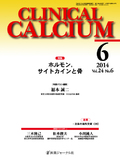Japanese
English
- 有料閲覧
- Abstract 文献概要
- 1ページ目 Look Inside
- 参考文献 Reference
骨の動的な恒常性は,破壊と形成のバランスにより保たれ,常に骨を新しく作り替えている。この再構築は“骨リモデリング”と呼ばれ,強靭な骨組織の維持のみならず,生命維持に必須なミネラルの代謝器官である骨を巧妙に制御している。破骨細胞の骨吸収後,骨芽細胞が欠失部分に過不足なく骨を形成する一連の現象をカップリングと呼び,骨の恒常性を保つために重要なシステムである。骨基質から骨吸収により放出されるTGF-βやIGFなどは古典的なカップリング・ファクターであるが,最近,破骨細胞の発現因子(clastokine)が骨芽細胞を制御するという概念も提唱されてきた。骨を構成する細胞のコミュニケーションやカップリングの制御機構の解明は,骨の生理および病態を理解する上で極めて重要であると考えられる。
Bone is constantly renewed by the balanced action of osteoblastic bone formation and osteoclastic bone resorption both of which mainly occur at the bone surface. This restructuring process called “bone remodeling”is important not only for normal bone mass and strength, but also for mineral homeostasis. Coupling has been understood as a balanced induction of osteoblastic bone formation in response to osteoclastic bone resorption. An imbalance of this coupling is often linked to various bone diseases. TGF-β and IGF released from bone matrix during osteoclastic bone resorption are the favored candidates as classical coupling factor. Recently, several reports suggest that osteoclast-derived molecules/cytokines(clastokine)mediate directional signaling between osteoblasts and osteoclasts into the bone microenvironment. Thus, the elucidation of the regulatory mechanisms involved in bone cell communication and coupling is critical for a deeper understanding of the skeletal system in health and disease.



